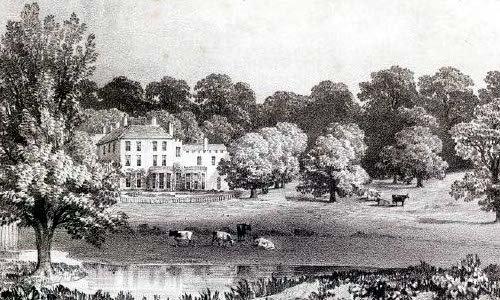Miss Hill Boothby was a close friend and regular correspondent with Dr Johnson. Their letters show strong affection if not romance.
Sir William Boothby of Broadlow Ash purchased the Hall and much of the estate in 1671 and his family lived there until the mid-19th century. The hall was considerably altered and additional land acquired to add to the deer park which had been enclosed by Sir Thomas Cockayne prior to 1537. This was landscaped and the brook widened to form fish ponds – these were again developed into a boating lake with ornamental islands and other follies by the later Boothby’s.
The Boothby’s were ‘away in the hills’ when Prince Charles Edward Stuart (Bonnie Prince Charlie) called to stay for the night on his way to Derby in 1745 following the declaration in Ashbourne market place of his father as King. The Scottish troops camped in the park and for many years an old Claymore was kept in the house as a reminder of the visit.
Sir Brooke Boothby, the 6th Baronet, was part of the intellectual and literary circle which included Anna Seward and Erasmus Darwin and other members of the Lunar Society and, in 1766, he welcomed the philosopher Jean-Jacques Rousseau to Ashbourne. Brooke Boothby married in 1784 and leased the hall from his father, whose extravagance had forced him to live elsewhere. He then began rebuilding it in 1785 using his wife's dowry to remodel the parkland, purchase rare plants and obtain works of art including the famous portrait of Boothby by Joseph Wright of Derby.
Brooke Boothby was extravagant, emotional and self-indulgence; his only daughter Penelope was born in 1785 and Sir Joshua Reynold's ‘Portrait of Penelope’, often called "The Mob Cap", is one of the most famous of English child portraits. On 19 March 1791, Boothby's daughter died at the age of five. This sad event permanently affected him and he subsequently published a book of poetry, Sorrows Sacred to the Memory of Penelope. A remarkable tomb was constructed for her in St Oswald’s Church Ashbourne which included a life-size figure, described as being so lifelike that the child could be sleeping. It is inscribed with an epitaph;
"She was in form and intellect most exquisite. The unfortunate Parents ventured their all on this frail Bark. And the wreck was total"
Boothby's life went into decline after his daughter's death and his wife Susanna returned to her parent's home in Hampshire settling in Dover. Her death was recorded under her maiden name of Bristoe. Boothby never recovered from the emotional loss and, financially crippled by his excesses, he left Ashbourne never to return; after roaming the continent he finally settled in diminished circumstances in Boulogne in 1815 and died there in 1824. The Park and Hall were eventually sold.
One of the grandest churches in Derbyshire, with a slender spire of 212 feet. Referred to in the Doomsday book, the present church building dates from the mid 1200's and contains fine stained glass and monuments.
In 1547 the Hall is drawn as a rambling gabled timber framed range of buildings built around a courtyard. This had clearly grown over the years and by the Hearth Tax returns of 1662 the house had 21 chimneys making it one of the largest private homes in Derbyshire. The old hall was replaced in Georgian times.
Ashbourne Park is a surviving part of a medieval deer park. It remained part of the Ashbourne Hall estate for over 800 years and was recorded as an impaled park on a map of 1547 and described in England’s oldest rhyming epitaph as one of three hunting parks created by the Cockayne family.












